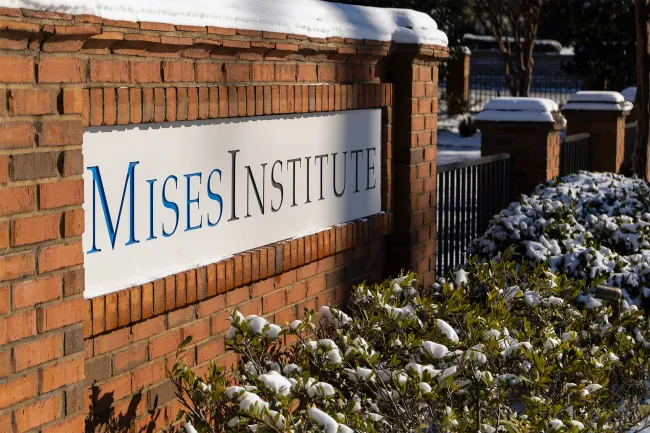One of the most rudimentary topics in mainstream macroeconomics is inflation, and specifically the different methods of “measuring” inflation, such as the Consumer Price Index (CPI) and Producer Price Index (PPI). These concepts are taught in practically every introductory macroeconomics course, and they play a central role in policy discussions about the economy.
One noteworthy, but often overlooked, aspect of this topic is that the specific terminology of “measuring inflation” is taken for granted as the way of describing this area of study. The popular economics YouTuber Jacob Clifford gives a typical presentation in a recent video on economic indicators: “Now we’re going to talk about how to measure inflation,” he says, introducing a new lesson. “The most common measurement of inflation is the Consumer Price Index, or CPI.”
This language has become so commonplace that economists rarely question whether it is appropriate. But Austrian economists have long taken issue with this seemingly innocuous terminological choice, and for good reason.
The Meaning of Measurement
According to the Oxford Advanced Learner’s Dictionary, to measure something means “to find the size, quantity, etc. of something in standard units.” We can think of a ruler being used to measure length in centimeters or inches, a thermometer measuring temperature in degrees Celsius or Fahrenheit, or a pressure gauge measuring pressure in kPa or psi, and so on.
Central to the concept of measurement is the concept of a fixed, universally recognized unit. To measure something is to express some kind of quantity in terms of the relevant unit. We can say, for example, that a light has a brightness of 5 lumens, that an object has a mass of 20 kilograms, or that an electric current is flowing at 200 amps. These statements are meaningful measurements because the quantities are relative to a known standard—in these cases, respectively, a lumen, a kilogram, and an amp. It’s true that there can be different units for the same phenomenon, but a simple conversion is all that’s needed to navigate between different systems of units.
With this understanding in mind, it quickly becomes clear that something is off when the concept of measurement gets applied to inflation. For instance, if we can really “measure inflation,” then what are the units of inflation? Dollars per year? That makes no sense. You wouldn’t “measure” inflation as being $5/year or $100/year.
Maybe what economists mean is that they are measuring the rate of change of the “price level.” What are the units of the price level?
This is where the index number approach is introduced, where the price of a “basket of goods” in a certain year is taken as a standard of sorts. But as Mises explains in Human Action, this too isn’t really a “measurement” in the proper sense of the word:
The pretentious solemnity which statisticians and statistical bureaus display in computing indexes of purchasing power and cost of living is out of place. These index numbers are at best rather crude and inaccurate illustrations of changes which have occurred….
In practical life nobody lets himself be fooled by index numbers. Nobody agrees with the fiction that they are to be considered as measurements. Where quantities are measured, all further doubts and disagreements concerning their dimensions cease. These questions are settled. Nobody ventures to argue with the meteorologists about their measurements of temperature, humidity, atmospheric pressure, and other meteorological data. But on the other hand nobody acquiesces in an index number if he does not expect a personal advantage from its acknowledgment by public opinion. The establishment of index numbers does not settle disputes; it merely shifts them into a field in which the dash of antagonistic opinions and interests is irreconcilable….
….In the praxeological orbit the concept of measurement does not make any sense. In the imaginary—and, of course, unrealizable—state of rigidity and stability there are no changes to be measured. In the actual world of permanent change there are no fixed points, objects, qualities or relations with regard to which changes could be measured.
When statisticians generate the CPI or PPI, they are not taking out the economic equivalent of a ruler and measuring something. They are simply manipulating data according to a set of arbitrary procedures.
An Alternative Term
If the arguments against the “measurement” terminology are so decisive, why has it continued to stay in vogue for decades? Perhaps the answer is that no suitable alternative has been proposed. It’s hard to ditch a useful term—even if it’s wrong—if you have nothing to replace it with.
In light of this, I’d like to offer up a term that I think should be considered as the replacement: quantify. Calculating the CPI, PPI, and so on should be regarded, not as measuring inflation, but as mere attempts to quantify inflation.
The merit of the word quantify is that it is more abstract, and thus more humble. It does not imply that we are ascertaining an objective metric. Instead, it gives the impression of “putting a number on it.” It makes no pretensions to be anything more than statistical manipulations—an admittedly crude method that’s simply an attempt to capture in a number how quickly prices are rising.
Whether quantify ends up being the best replacement or not, what’s clear is that the terminology of “measuring” inflation needs to be exorcised from the economics profession. As The Princess Bride so eloquently put it, “You keep using that word. I do not think it means what you think it means.”


